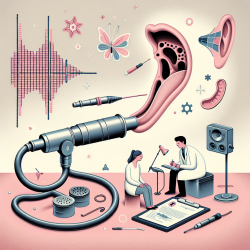The field of speech therapy is continually evolving, with new research providing valuable insights into improving therapeutic outcomes. One such advancement is the use of nasoendoscopy to assess velopharyngeal function, particularly in patients with cleft palate. A recent study titled "Nasoendoscopy of Velopharynx Before and During Diagnostic Therapy" offers critical findings that can enhance the practice of speech-language pathologists (SLPs).
The Importance of Nasoendoscopy
Nasoendoscopy is a crucial tool for evaluating the velopharyngeal mechanism during speech. It allows clinicians to observe the movement of the velum and pharyngeal walls, as well as the size and shape of any gaps that may contribute to velopharyngeal dysfunction (VPD). This visual feedback is invaluable for tailoring therapy to each patient's needs.
Key Findings from the Study
The study analyzed nasoendoscopic recordings of ten children with operated cleft lip and palate. The researchers assessed velar and pharyngeal wall movements before and during diagnostic therapy. The findings revealed significant improvements in velopharyngeal function when patients were guided to increase intraoral air pressure:
- The displacement of the right and left lateral pharyngeal walls increased by 70% and 80%, respectively.
- A reduction in gap size was observed in 30% of patients, while 40% experienced a complete disappearance of gaps.
The study underscores the importance of using diagnostic therapy strategies to manipulate velopharyngeal function actively. By encouraging patients to increase oral air pressure, SLPs can elicit greater movement in the velopharyngeal structures, potentially reducing or eliminating gaps that affect speech quality.
Practical Applications for Practitioners
The implications for practitioners are significant. Incorporating diagnostic therapy into nasoendoscopic assessments can optimize the information gathered during evaluations. This approach not only enhances the accuracy of assessments but also informs more effective treatment plans.
SLPs should consider the following strategies:
- Use Visual Biofeedback: Employ nasoendoscopic feedback to guide patients in adjusting their speech production techniques.
- Tailor Therapy: Customize speech stimuli based on individual patient needs and observed velopharyngeal function.
- Monitor Compensatory Maneuvers: Be vigilant about unwanted compensatory responses that may skew assessment results.
The Path Forward: Encouraging Further Research
This study highlights the potential for diagnostic therapy to improve speech outcomes significantly. However, further research is needed to explore its application across different speech sounds and longer speech samples. Additionally, understanding the role of Passavant's pad during speech production warrants further investigation.
The integration of nasoendoscopy with diagnostic therapy represents a promising direction for enhancing speech therapy practices. By continuing to explore these techniques, practitioners can offer more effective interventions for individuals with VPD.
NASOENDOSCOPY OF VELOPHARYNX BEFORE AND DURING DIAGNOSTIC THERAPY










